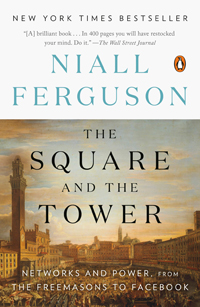 Niall Ferguson, The Square and the Tower: Networks and Power, from the Freemasons to Facebook (New York: Penguin Press, 2017), 592pp.
Niall Ferguson, The Square and the Tower: Networks and Power, from the Freemasons to Facebook (New York: Penguin Press, 2017), 592pp.
A review by Brad Keister, former Deputy Division Director of the Physics Division for the National Science Foundation.
The Scottish historian Niall Ferguson, currently a senior fellow at Stanford's Hoover Institution, argues that present-day controversies about social media are not without precedent, and that they are best understood within the context of hierarchies (governments, companies, and organized churches) and networks (groups of people sharing a common attribute). Networks (both animate and inanimate) have been studied extensively over the past few decades, and Ferguson uses network methodology as a historical lens. Hierarchies are inherently structured for self-preservation: major changes can only come from the outside, and networks often play a critical role. Ferguson provides many examples, including the American and French Revolutions.
Networks can spawn and incubate new ideas, but they are inherently ungoverned. For all the flaws of hierarchy, Ferguson argues that they are ultimately needed to rein in the chaos that networks eventually lead to on their own.
There is much discussion as to whether Western states will revert to the totalitarian entities of the First and Second World Wars, but Ferguson claims that this is the wrong perspective, and that we would do better to look back to an older technological advance: Gutenberg’s invention of moveable type, which enabled common citizens to exchange information at unprecedented levels. This in turn led to civil strife that toppled hierarchies and ushered in a century of violent conflicts. The modern counterpart to the printing press is the internet, and Ferguson sees far more upheaval yet to come before Western society comes to terms with it.
Dan Clendenin: dan@journeywithjesus.net


